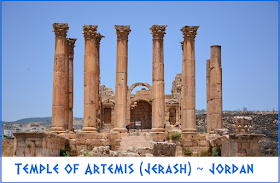Ancient Greek inscriptions establish the foundation of the city as being by Alexander the Great or his general Perdiccas, who settled aged Macedonian soldiers there (Gerasa=Old) during the spring of 331 BCE, when Alexander left Egypt, crossed Syria and then went to Mesopotamia. However, other sources, namely the city's former name of 'Antioch on the Chrysorrhoas', point to a founding by Seleucid King Antioch IV, while still others attribute the founding to Ptolemy II of Egypt.
After the Roman conquest in 63 BCE, Jerash and the land surrounding it were annexed to the Roman province of Syria, and later joined the Decapolis league of cities. The historian Josephus mentions the city as being principally inhabited by Syrians, and also having a small Jewish community. In 106 CE, Jerash was absorbed into the Roman province of Arabia, which included the city of Philadelphia (modern- day Amman). The Romans ensured security and peace in this area, which enabled its people to devote their efforts and time to economic development and encouraged civic building activity.
Jerash is considered one of the largest and most well-preserved sites of Roman architecture in the world outside Italy. It is sometimes misleadingly referred to as the "Pompeii of the Middle East" or of Asia, referring to its size, extent of excavation and level of preservation.
Jerash was the birthplace of the mathematician Nicomachus of Gerasa (Greek: Νικόμαχος) (60 CE – 120 CE).
In the second half of the 1st century CE, the city of Jerash achieved great prosperity. In 106 CE, the Emperor Trajan constructed roads throughout the province, and more trade came to Jerash. The Emperor Hadrian visited the city in 129–130 CE. The triumphal arch (or Arch of Hadrian) was built to celebrate his visit.
Source: Wikipedia







No comments:
Post a Comment